In this article, we will look at the grounds, if any, for distinguishing two groups of Christians, a laity and a clergy. First of all, it is important to recognise that the terms “laity” and “clergy” are not used in the Bible in a technical sense. When they are used at all, they are not used as opposites. Nowadays, however, they normally represent two clearly distinct groups within the Church. This is not only the case in everyday language but also in most versions of current Church law.
The word “laity” comes from the Greek “laos”, which means “people”. It refers to the whole people of God. Since those who are called “clergy” belong to the people of God, they are, strictly speaking, included in the laity.[1] The words “clergy” and “cleric” or “clerk” come (via Old French) from the Latin word “clericus”, which means “a learned, knowledgeable, erudite man”.
In turn, the Latin word “clericus” comes from the Greek kleros, which means a lot or portion which is either inherited, received by casting a lot or assigned. In Roman society, learning was indeed a kind of lot or inheritance. In the Church, a priest would be called “cleric” both on account of the portion of the people of God (the congregation) he was responsible for and on account of his learning.
The idea of lot or portion is also still echoed in the term “benefice”, a portion of the diocese, along with its population, from which a priest would receive his income (benefits). Central in such terminology was what the priest received from the people, not what the people received from the priest. According to Douglas Harper’s online etymology dictionary, it was only around 1300 AD that “cleric” came to mean “one who is ordained”.
It gets even more interesting when we look at how the Greek word kleros was used in the New Testament. In the gospels, it is only used for the lots which were cast by the Roman soldiers to divide Jesus’ robe. In the first chapter of Acts, it is used for Judas’ lost “share” in the ministry (diakonia) of the apostles and for the lot which was cast to select another apostle, namely Matthias. In chapter 8 Peter tells Simon the sorcerer that he can have no part or share of the Holy Spirit. All genuine Christians (not only the apostles!) could (and still can) have such a share of the Holy Spirit, though. In chapter 26 the risen Christ orders St. Paul to open the eyes of the gentiles (non-Jews) so that they may have a place (share, inheritance) among those who are sanctified by faith. So this is not about St. Paul’s own lot or share. In his letter to the Colossians the same Paul then thanks God that his readers “share in the inheritance of his holy people in the kingdom of light”. Again this is not about Paul’s own share or lot as an apostle!
The only text in which “kleros” refers to a group of people is 1 Peter 5:2,3, where the elders of various congregations are admonished to “be shepherds of God’s flock that is under your care… eager to serve, not lording it over those entrusted to you, but being examples to the flock”. So the only text which uses the word “kleros” in a sense that comes close to its later use, emphasises that this is not about a hierarchical relationship, but about “managing by example” and states that the flock is God’s.
It should also be noted that in verse 5 the elders are contrasted with the younger people. Therefore, even though oversight / supervision / watching over is mentioned in verse 2, “elders” does not necessarily refer to bishops or priests as we know them today, but to all local Christians who should set an example because of their literal seniority and experience. In the second part of verse 5, both elders and young people are asked to “clothe [themselves] with humility toward one another”. This is far from naming yourself after those entrusted to you as if the people were your personal possession or inheritance.
I can only conclude that, from the perspective of the New Testament, the current use of the words “cleric” and “clergy” adds very little to our understanding of Christian ministries and may even lead us astray. It is hard to understand how they could become so important and why they would not seldom be used to legitimise the very “lording over” that St. Paul was trying to discourage. In any case, the New Testament does not offer us a strong case for making a sharp division between clergy and laity. kleros and laos are clearly Biblical concepts, but there is no suggestion in Scripture that the kleros are a class or group of persons distinct from (or distinct within) the laos. All Christians are God’s people (laos) as well as His flock or inheritance (kleros).
When he was still vicar of St. Nicolas, Durham, archbishop Carey wrote, “There is no room for distinctions between kleros and laos, between clergy and laity. The laos is the people of God, and all are kleros because all are called to exercise functions within the body.” He called this “a most important truth for a modern church“. From: “The Origins of the Threefold Christian Ministry, based on a lecture first given at the Evangelical Staffs’ Conference in 1980.
External influences
This, of course, raises the question when the distinction between the two terms and, with it, between the two groups, came about. There is little doubt among church historians that this happened very soon. As people converted from Judaism and from other religions, they tended to bring with them the sacerdotalism of Judaism and the traditional notions of their pagan religions. Especially the church fathers Tertullian and Cyprian gradually planted seeds for the distinction of two classes, teachers and laity, until by the 3rd century the clergy was an institution in its own right. Tertullian (end of 2nd century) may have been the first one to use the Latin word “clerus” in the sense of clergy (On monogamy, chapter 12). Before that, interestingly, Clement of Rome already defended the new priesthood by referring to the peculiar services assigned to the Jewish high priest, the priests and the Levites, with the “layman” being bound by the laws that pertain to “laymen” (1st Letter to Corinth, ch. 40).
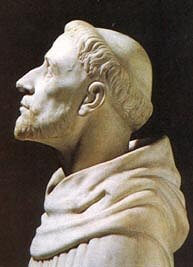 Church historian Charles Jacobs summarises, “In the beginning, most of the work of the congregation was done by people who had no official position. It was voluntary service, freely rendered. By the middle of the third century, it was done by the professional clergy. Between clergymen and laity, there was a sharp distinction. The clergy, too, were divided into higher and lower grades. In the higher grades were bishops, presbyters and deacons; in the lower grade sub-deacons, lectors, exorcists, acolytes and janitors. All of them were inducted into office by some form of ordination, and the idea of local organisation had gone so far that in some churches even the grave diggers were ordained. Thus the work of the Church was passing out of the hands of the many into those of the few, and these few were coming to be regarded as belonging to a higher class.” (The Story of the Church).
Church historian Charles Jacobs summarises, “In the beginning, most of the work of the congregation was done by people who had no official position. It was voluntary service, freely rendered. By the middle of the third century, it was done by the professional clergy. Between clergymen and laity, there was a sharp distinction. The clergy, too, were divided into higher and lower grades. In the higher grades were bishops, presbyters and deacons; in the lower grade sub-deacons, lectors, exorcists, acolytes and janitors. All of them were inducted into office by some form of ordination, and the idea of local organisation had gone so far that in some churches even the grave diggers were ordained. Thus the work of the Church was passing out of the hands of the many into those of the few, and these few were coming to be regarded as belonging to a higher class.” (The Story of the Church).
When we think about such developments in the Early Church, in what is sometimes called the Patristic period, the period of the Church Fathers, we are placed in a difficult dilemma. On the one hand, we want to recognise a possible unrecorded oral tradition (deposit of faith), preserved by the Church. We also want to recognise the important work of the Church Fathers, and an amount of guidance of the Holy Spirit in the areas of theology, apologetics (defending the faith) and church organisation. Tradition would become one of the pillars of the Roman Catholic, the Anglican and other Churches.
On the other hand, most scholars also recognise that the Church has never been an island of perfection. For instance, on the 20th of April 2007 Pope Benedict XVI declared that unbaptised deceased children were not eternally lost, after all, but were with God in heaven. Just think of the misery the parents of such children had gone through for centuries, just because the Church had been holding on to cruel human doctrines for so long. Now the Church may have done the best she could under specific circumstances. Then I still don’t understand her earlier position, but at least it will then have to be admitted that certain customs and interpretations were related to the cultural and political needs of the day. Every generation will, therefore, have to look at things again in the light of new challenges posed by its environment, but also of old challenges which no longer apply.
Sometimes reforms are needed because certain adaptations, however ancient, are no longer functional. Also, in retrospect, those adaptations may not even have been in line with the teaching of Christ (as in the example above). To prevent error, new insights and reforms should always be tested against generally accepted and tested doctrine and tradition, but doctrine and tradition themselves should still be tested against and remain subordinate to the evidently essential message of Christ.
The test of time alone (noticing that traditions have survived) is not enough. Compare this to Bible translations. When we prepare a new translation, we may look at existing ones, but we base ourselves primarily on the original Hebrew and Greek. Likewise, tradition serves us by showing how certain Biblical principles were extracted, expressed and applied in a certain period, but it cannot be our primary source.
So we must disagree with the Council of Trent’s declaration that the Bible and Church Tradition (the tradition that made up part of the Catholic faith) are equally and independently authoritative. How can Church tradition be independent of the New Testament record? Even if the New Testament is considered, as some do, as part of the Church’s tradition, one part of that tradition cannot be independent of another part. Trent, by the way, was the same council in which the office of priests was declared to be so “divine” that priests should have an array of servants.
Going back to the roots
In the case of the clergy-laity issue, there is much friction between some of the earliest traditions and the slightly earlier message of Christ as it comes to us in the gospels and the rest of the New Testament. If I was the only one to say so, I would be very hesitant, but many reformers over the ages have said the same. Even the Roman Church had to make some important adjustments to their theology to somewhat bridge the gap between its institutions and practices on the one hand and their biblical roots on the other, as we will see when discussing the priesthood of all believers and Vatican II. So this is not an instance of one individual rejecting the accumulated wisdom of the Church. Rather, I am drawing attention to these inconsistencies because relatively few Christians, including clergy, seem to be aware of them or fully realise the implications.
This lack of awareness may be part of the reason why the Church finds it so hard to change or to express the Gospel in contemporary language. We may simply have been too faithful to things that were secondary or even contrary to the intentions of the gospel. As Christ said, no one can serve two masters. The Church, by becoming and remaining a mistress in her own right, may thus have placed her own children in an impossible conflict of loyalty.
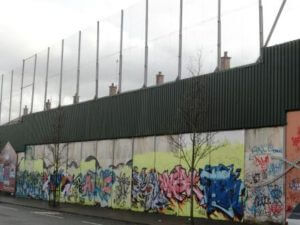
A dividing wall in Belfast
Besides, it is unlikely that Jesus broke down dividing walls (Rom. 10:12, Eph. 2:14,15) only to make room for new ones. What kind of dividing wall was meant in Ephesians 2:14,15, anyway? True, this wall did not refer to a division between laity and clergy, but between Jews and Gentiles. However, the Greek word used here, fragmos (φραγμός, fence), is a rather interesting one. Normally the Greek word would be different (either teichos/toichos or drufaktos). Tim Hegg, on a website called “Messianic publications”, convincingly argues[2] that therefore, fragmos cannot refer to the wall around the temple or dividing its courts, but rather points to the “oral traditions” which were added to the Torah (the Law as recorded in the books of Moses).
In a similar way, traditions would be added to the New Testament. This is fine, as long as they do not introduce new divisions. Unfortunately, that is one of the things they tend to do[3] and did. Now Jesus did not reject all traditions[4], so we do not have to reject all Christian traditions either, but as He was selective, so should we. Anything which is divisive or has that potential should raise our suspicions. The distinction between laity and clergy is such an element of tradition, which deserves more scrutiny instead of the almost automatic perpetuation we have seen so far.
Then I found that the word fragmos is also used, in Luke 14:23, to indicate “a path or area along a fence, wall, or hedge. It then refers to a place where desperately poor people might stay, a ‘byway, path’”[5]. In this text, Jesus tells his disciples to ‘go out into the highways and byways (fragmos) and make them come in so that my house will be full’. Here, too, divisions are taken away. Ephesians 2:14 goes a step further, by, as it were, removing the byways themselves. What remains is only one royal road (highway) into the house of God.
As Tim Hegg writes in his article, the “teaching of the ingrafting of the Gentiles was perhaps the most difficult Apostolic doctrine for the Jewish believers to accept. For centuries the Jewish nation had borne her distinction from the nations and welcomed proselytes [converts; ed.] who not only embraced the God of Abraham, Isaac and Jacob but willingly ‘became Jews’. The apostolic teaching, however, denied that such was ever necessary. Gentile believers were to be accepted as full citizens within the believing community without undergoing the ritual of a proselyte”.
Has the church now “for centuries” held on to a similar distinction between two classes of believers, again requiring extra rituals[6] in order to enjoy full privileges within the family of God? As I am writing this, I am looking forward to attending a conference about the spirituality of (mainly ordained) ministers. By the way, the Dutch word for clergy is “geestelijkheid” (the spiritual ones), which may have left ordinary Christians wondering if they can have any significant spirituality! The fact that this group of ministers are now wondering about their own spirituality and how it differs from the spirituality of the laity, is a good thing because, in essence, that spirituality should not be different. May this conference help towards the realisation that the whole distinction between clergy and laity is problematic, to begin with.
Objections
Let me deal with two possible objections. Firstly, some may point to the letter of St. James, 3:1, where it says that not many should be teachers. I am not, however, denying the existence of a number of separate ministries, each with its own responsibilities. The problem arises when two groups are distinguished, one claiming to encompass most ministries, like teaching, pastoral care, leadership and so on, leaving the other group to consist of some “helpers” or assistant teachers and a large contingent of “members” without any recognised ministry. I am also referring to a culture in which the term “vocation” points, in 95% of all cases, to the ordained ministry. The New Testament does not comment on this situation because it is so alien to its thinking, but I have tried to show that a diversity of mutually cooperating ministries comes much closer to the New Testament ideal.
Secondly, people may object saying that a distinction between clergy and laity is not so bad until it is given too much attention. There are more important things to consider in our mission to the world. Let me point out that this is exactly the argument that has been used time and time again to slow down necessary reform. When women wanted to be ordained it was also claimed that this “desire” or “ambition” was not something which should use up a great deal of their time. This time could have been used to support the mission of the Church. There are so many ways in which women and lay members can be of service! That, however, is not the point.
The point is that many men and women in the Church began to understand that the equality of all God’s children is one of the core values of the gospel. The Church would, therefore, have to set an example and grant this equality at all levels within its organisations. Once in certain positions, women would then also more effectively be able to contribute to the further transformation of Church culture.
Not ready for this debate
Before 2017 not many people spoke about the perceived inequality of ordained and non-ordained Christians. Various other inequality problems demanded (and still demand) their attention. However, the dynamics are the same. I would hope that especially women would understand the mechanisms of inequality and consider their new positions not as an end in itself, but as a way of challenging all kinds of inequality. As I said, it may be too early to expect a lot of enthusiasm for abolishing the term “clergy” while it can still be used as an instrument of change, but eventually, it will have to be addressed.
An important reason for expanding the “equality” debate is that the lack of equality in several areas has already caused many to regard the Church as antiquated, irrelevant and unfair. The Church has been caught contradicting itself. For many decades already, such contradictions have been one of the factors behind the ever shrinking church attendance. People are giving up on the Church as we fail to be pioneers of justice and compassion, but continually seem to follow (at some distance) those changes in society which are perfectly in line with the gospel.
These positive changes in society may even have been inspired by the gospel at one time, but we have not led the way. Instead, we have maintained a predominantly male and hierarchical way of thinking and organising. So the assumption that divisions and inequalities in the Church are harmless as long as they are unchallenged is clearly incorrect. Radical changes are needed to bring the Church back to the frontline of liberation from all kinds of marginalisation. I am afraid we cannot do so without radically revising some of our language, customs and concepts.
Renewal and Reform
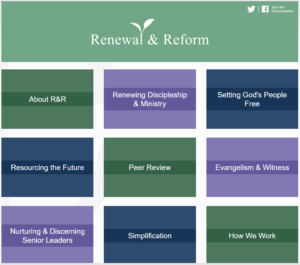 The Church Times of 14 October 2016 featured an article about the new Anglican “Renewal and Reform” report by the Lay Leadership Task Group. This had been approved by the Archbishop’s Council the month before. It would still have to go through the House of Bishops with a view to presenting it in the Synod in February 2017. Initially, the report did not dwell on specific changes in or even growth of lay ministry positions. It emphasised two shifts in culture and practice which the Archbishop’s Council considered “critical to the flourishing of the Church and the evangelisation of the nation”. [7]
The Church Times of 14 October 2016 featured an article about the new Anglican “Renewal and Reform” report by the Lay Leadership Task Group. This had been approved by the Archbishop’s Council the month before. It would still have to go through the House of Bishops with a view to presenting it in the Synod in February 2017. Initially, the report did not dwell on specific changes in or even growth of lay ministry positions. It emphasised two shifts in culture and practice which the Archbishop’s Council considered “critical to the flourishing of the Church and the evangelisation of the nation”. [7]
Now what were these two culture shifts? First, ordained and lay people must collaborate to form and equip lay people in discipleship. Secondly, ordained and lay people must be “convinced that they are equal in worth and status and complementary in gifting and vocation – equal partners in mission”. Quite correctly, the present culture was seen as having a big problem regarding the clergy-laity dichotomy. Bishop Philip North, however, stressed that the report was “not an all-out criticism of current relationships between the clergy and laity, which were largely healthy”. He just saw an “opportunity to change the way in which the laity are perceived”. The laity only?
I would have thought you can only change the way the laity are perceived by also changing the way the clergy are perceived, but I may be mistaken. Also, the relationship between individual representatives of clergy and laity was not the point. This was (or wasn’t it?) about the relationship between two institutions within the Church. These institutions continue to be fostered even as they severely diminish the effectiveness and even credibility of the Church. I fully agree with Bishop North that the current role of the laity is quite often “filling the gaps left by retreating clergy. Strategic future decisions have been made too often by clergy and bishops who are not hearing the voice of the laity”. Now, will this new plan change all that? As I write this, it is probably too early to tell. I know from experience, though, that culture changes are notoriously hard to achieve, especially when they are also result-driven, predominantly top-down and have to traverse multiple committees. They can also fail by not being radical enough.
I have mixed feelings about the “renewed emphasis … on the laity as disciples”. Just like the term “laity” itself, “disciples” really applies to all Christians. To then use it in a technical sense does not really solve any problem. We can all agree that the laity (but not only the laity!) are “called to a life of learning and formation in the likeness of Christ”[8] but I miss an analysis of the factors that caused the development of discipleship in the laity to stifle. I am fairly sure, though, that the clergy-laity distinction itself has been one of those factors. Now, while many Church leaders still claim that the term “all-member-ministry” is a misnomer, this report “sees lay people as absolutely the front line in every sphere of life and aspect of the world”. Marvellous, isn’t it?
All the clergy will have to do is to facilitate it. The chairman of the CRC had stated[9] that an intended increase in numbers of ordinands by 50% does not mean an increase of 50% in numbers of clergy. He played it down, so as to mitigate the shock to lay ministers. However, a 2017 update[10] on “Renewal and Reform” speaks of an “increase of at least 50% in ordinations” and of younger, more diverse candidates with a wider range of gifts. How it will be possible to simultaneously work on “rapid development of lay ministries” is beyond me. In any case, implementation usually comes after development, so the actual consequences for the laity may follow later on. The way it works is that all Dioceses had to apply or will have to apply for “Strategic Development Funding”[11] and start their own projects. Peer reviews between Dioceses were/are meant to provide “mutual accountability” and “shared learning”. This, however, can hardly be expected to produce a uniform approach, so it will probably create new inequalities.
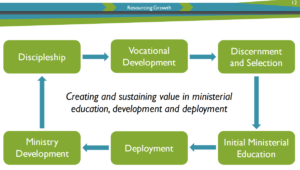 I picked up the following diagram from the update on “R&R”. I like it because nowhere does it mention clergy or laity. You know what they say, “If it seems too good to be true, it usually is”. However, I don’t just say this to be negative. I sincerely hope that solutions will be found that will go beyond subtle changes in terminology or funding but will bring about true “shared ministry” with priority being given to a respectful treatment of existing and new “resources”. The Church, after all, is not a machine and God forbid that she would become more and more like a machine.
I picked up the following diagram from the update on “R&R”. I like it because nowhere does it mention clergy or laity. You know what they say, “If it seems too good to be true, it usually is”. However, I don’t just say this to be negative. I sincerely hope that solutions will be found that will go beyond subtle changes in terminology or funding but will bring about true “shared ministry” with priority being given to a respectful treatment of existing and new “resources”. The Church, after all, is not a machine and God forbid that she would become more and more like a machine.
Our sacred universe
 I would like to conclude with a quote from Richard Rohr’s daily meditations newsletter.[12]
I would like to conclude with a quote from Richard Rohr’s daily meditations newsletter.[12]
“Most religious searches begin with one massive misperception. People tend to start by making a very unfortunate, yet understandable, division between the sacred and the profane worlds. Early stage religion focuses on identifying sacred places, sacred time, and seemingly sacred actions that then leave the overwhelming majority of life unsacred. People are told to look for God in certain special places and in particular events—usually, it seems, ones controlled by the clergy. Perhaps this is related to the clergy’s need for job security, which is only natural. Early stage religion has limited the search for God to a very small field and thus it is largely ineffective—unless people keep seeing and knowing at larger levels. In Franciscan (and true Christian) mysticism, there is finally no distinction between sacred and profane. The whole universe and all events are sacred, serving as doorways to the divine for those who know how to see. […] For those who have learned how to see fully, everything—absolutely everything—is “spiritual.” This eventually and ironically leads to what the Lutheran mystic Dietrich Bonhoeffer (1906-1945) called “religionless Christianity.” [2] Bonhoeffer saw that many people were moving beyond the scaffolding of religion to the underlying and deeper Christian experience itself.”
It follows that, on this most basic and profound level, there are no non-sacred or less holy ministries as opposed to holy orders. So when a senior clergyman says that Readers should be “not in holy orders, and occasionally even ‘out of order’”[13], this is not just a condescending semi-joke, but superficial and making fun of something holy. There is, by the way, a thin line between wanting people to feel “confidently lay” and wanting them to feel “confidently inferior”. He was right, however, when implying that it is sometimes necessary and justified to appear to be “out of order”, namely for the sake of arousing some from their smug and “holy” complacency.
It even follows that “secular” vocations are sacred, too. It follows that there is spirituality in being unemployed against your will. It follows there is spirituality in a man dying on a cross! A good friend of mine used to say, “There is much religion in the baking of a good loaf of bread”. Richard Rohr wrote elsewhere that we do not have to make things sacred because they are sacred by nature. All parts of visible creation point to the invisible Creator. Read Psalm 148 or the Benedicite! All we humans can do – and this, unfortunately, happens a lot – is to desecrate what God made sacred.
In spite of all her good intentions and claims to the contrary, the Church seems to be no exception when it comes to walking into this particular pitfall. In this case the desecration occurs by labelling the majority of believers as “laity”. The fact that “laity” once meant “people (of God)” is no excuse, for today the only meaning is negative, i.e. not clergy, not professional, kind of dumb. It does not help to say that the laity is important, because this may still sound like “we need simple foot-soldiers to carry out our plans”. It does not help to speak about collaboration, because there always has been collaboration. We need to look at the kind of collaboration.
The good news is that it is not too late to discover, honour, and protect the sacred in all things and in all people. For some time to come, our world and our churches will probably continue to differ from the ideal within the Kingdom of God, but that does not relieve us from the obligation to pursue this ideal as much as possible. I suggest we take the simplest measures first. This includes abolishing the words clergy and laity altogether.[14] There are plenty of alternatives. As part of a whole range of equality issues, this might be more “critical to the flourishing of the Church and the evangelisation of the nation” than many realise.
Footnotes
[1] This is seldom mentioned and when it is, it is often to demonstrate that the laity is not “less” than the clergy. After all, if the clergy are still part of the laity, how can the laity be inferior? This is a specious argument. The queen is a human being, but that does not mean all human beings have the status of a king or queen.
[2] http://messianicpublications.com/tim-hegg/the-dividing-wall-in-ephesians-214/
[3] Our word “fragment” comes via Latin from the Proto-Indo-European root bhreg, which means to break. I have not been able to find proof, but I would not be surprised if the Greek “fragmos” came from the same root. Any wall or fence breaks the land in two parts. This brings division or fragmentation. Too many traditions also result in a fragmentation of the message, so that the main teachings can easily be lost.
[4] Just one of the many examples listed by Tim Hegg, is Matt. 15:36. There is nothing in the written Torah about giving thanks before eating. Saying the berakah before eating is part of the oral Torah.
[5] Wam Greek English Lexicon of the New Testament, Based on Semantic Domains.
[6] In Biblical times, the laying on of hands was used for a variety of things, but not to create two classes of citizens within the Kingdom of God. Besides, ordination ceremonies contain much more ritual than just the laying on of hands.
[7] Either the Church of England always forgets that they are present outside of “the nation”, in the form of the Diocese in Europe, or they think that evangelism on the other side of the Channel is someone else’s responsibility…
[8] As expressed (at the time) on the C of E webpage on Renewing Discipleship and Ministry. This page has changed since and now speaks of (alternatingly) lay, collaborative and shared ministry.
[9] See the article about Reader Ministry
[10] https://www.churchofengland.org/media/2452408/renewal_and_reform_presentation_160217_item_17.pdf (now removed or changed place; see https://www.churchofengland.org/about/renewal-reform).
[11] Or for “Lowest Income Communities Funding”.
[12] Richard Rohr, Franciscan Spirituality: Week 2, Learning to See, Thursday, June 15, 2017.
[13] Looking to the future, by bishop Robert (then chair of the Central Readers Council), The Reader, Autumn 2016, Vol. 116, No 1, p. 5.
[14] Cf. http://www.esgetology.com/2011/07/07/just-a-layman/



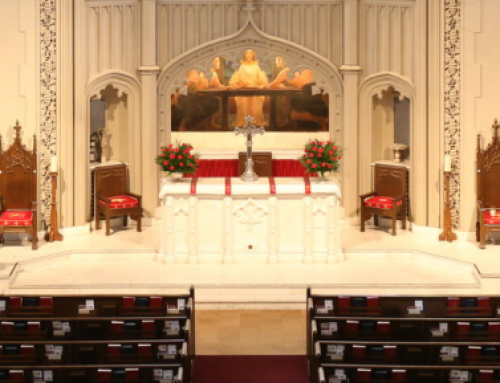

[…] [40] See https://www.emendatio.nl/clergy-laity-dualism/ […]
[…] [22] See the final section of my article on clergy and laity, https://www.emendatio.nl/clergy-laity-dualism/ […]
Hello,
I came across this article while searching online. I was searching for anything to help me come to a place where I could comfortably and in good conscience enter the Anglican priesthood. I feel very strongly that the clergy vs. laity dualism is not Biblical, but at the same time, I feel so strongly called to becoming a priest. How’s that for paradox? Your article was helpful in working out some of the issues. I wonder if God is calling me to work for change *from within* the system. I don’t know. I appreciate your article.
Chris Eaker
Hi Chris, I am pleased that you found my article helpful when considering your vocation. There are Anglican priests who avoid the word “priest” and use “presbyter” or other terms instead. But in so doing, most of them also avoid any real theological discussion about the nature of the priesthood. There is also a practical problem. You cannot fulfill all the tasks you may feel called to do, unless you are considered as a priest or an ordained minister. The problems surrounding ordination are similar to the ones surrounding “clergy”. By the sound of it, it is very likely that God is indeed calling you to work for change from within the system. That is what I would have done (and as a Reader am trying to do, without the same authority as a clergy-person). The challenge will be to hold on to this vision once you are ordained. I have seen too many people preaching equality make concessions once they were celebrated and admired as a priest. What is needed is that all Christians are encouraged to take up their role as fellow-priests and fellow-heirs of ALL promises. Have you read my article The revolution according to Hebrews? If not, I encourage you to do so. I am curious how you will use your knowledge. You can keep me updated if you want.
Jacob, yes I have read that one, too, and many more on this site since I discovered it yesterday.
I will let you know how it goes. Are you aware of any helpful books on this topic? I read on another one of your articles that you are planning to write a book.
Would you mind if I emailed you about this? I would welcome a discussion with someone as learned as you are on this topic. I do not see an email address on here which may be on purpose. But if that would be OK, then you could email me at my email and let me know. Thank you and merry Christmas!